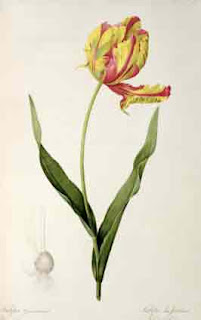Pierre Joseph Redoute (1759 - 1840) has been described as the greatest botanical artist of the golden era of botanical illustration.
Redoute was born in Liege, Belgium, but he left home at the age of 13. He spent ten years travelling and painting before he joined his brother in Paris where he worked as a theatrical scene painter. He began to frequent the Jardin du Roi (the King's Garden) where he met the wealthy botanist Charles Louis L'Hentier de Brutelle. L'Hentier recognised Redoute's talent and taught him how to dissect flowers, making him a better botanical artist, before employing him to illustrate two botanical studies.
At the same time Redoute also became a protege of Gerard van Spaendonck, the professor of flower painting at the Jardin's museum. By 1793 Redoute and his younger brother were working full time at the museum and had been noticed by royalty. Marie-Antoinette appointed him as her court painter. Later he was asked to visit the doomed royal family in prison during the Revolution as a rare cactus plant was in bloom and they wanted the image captured in a painting.
After the Revolution Napoleon Bonaparte's wife, Josephine, commissioned a series of paintings of the flowers in her garden at Malmaison. He set out with the intention to capture the flowers "with all the fidelity that science can desire, and, which is more difficult, with the luxury of detail with which nature has embellished them..." The plates of these paintings became two books: Jardin de Malmaison (1803 - 1804) and Description des Plantes Rares Cultivees a Malmaison et a Navarre (1812 - 17).
His most famous works were Les Liliacees (1802 - 16) and Les Roses (1817 - 24).
His work was extremely popular and enjoyed by a wide audience during his lifetime because a large number of engravings of his work were produced. Redoute helped to improve engraving techniques: in order to capture the dimentionality of his original paintings he used a stipple effect rather than lines.
In 1822 Spaendonck died and Redoute succeeded him as Master of painting at the museum where he passed on his love of nature to his students until his death in 1840.
His work is still very popular today (and out of copyright!) so it is frequently used on cards and pottery etc.









Lovely post and very interesting. Oh for the ability to be able to paint like he does - what a talent.
ReplyDeleteAs a rose lover I think you made an interesting post regarding P.J. Redouté. You showed us some beautiful paintings. I have a Redouté book on his rose paintings.
ReplyDelete